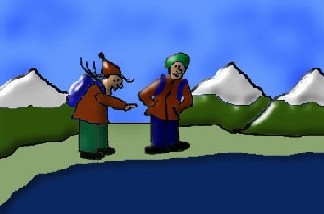Click on image for full size
Windows to the Universe original image
The Search for Life on…Earth!
News story originally written on November 3, 2002
By studying the small life forms in lakes almost 20,000 feet above sea level in the Andes Mountains of Chile, scientists hope to learn how life may survive in other harsh environments throughout the solar system.
One of the lakes that is being studied this month is a caldera that sits atop Licancabur volcano in Chile. A caldera is the name for a lake that forms in the collapsed top of a volcano. The harsh environmental conditions at this caldera make it one of the most Mars-like places on Earth.
The environment is tough to survive in because at high altitudes pressure is lower so there are less oxygen molecules in each breath of air, more ultraviolet (UV) sunlight, and it is very cold.
Even though the caldera on top of Licancabur volcano is in harsh environmental conditions, certain microorganisms can survive there and the scientist team from NASA, the SETI Institute and other organizations hope to learn how they survive. “Only by going there will we find out,” says Dr. Nathalie Cabrol, the principle investigator of the project. If scientists know how organisms survive in harsh environments on Earth, they will better understand the ways that life may have adapted to exist in environments such as those on Mars, or Jupiter’s moon Europa, today or in the past.
The 25-day mission to the high mountains of the Andes began on October 16, 2002 and will include mapping the crater’s geology and topography, surveying the depth of the lake and the temperature of the lake bottom, characterizing the organisms that live in the lake and testing a 2-wheeled Mars mini-rover.















